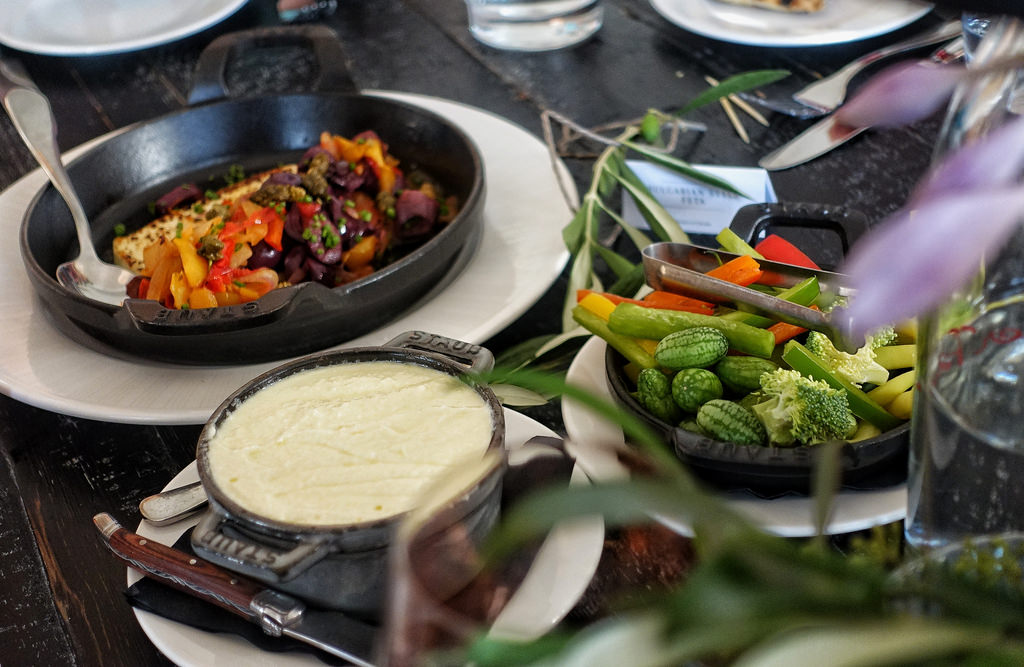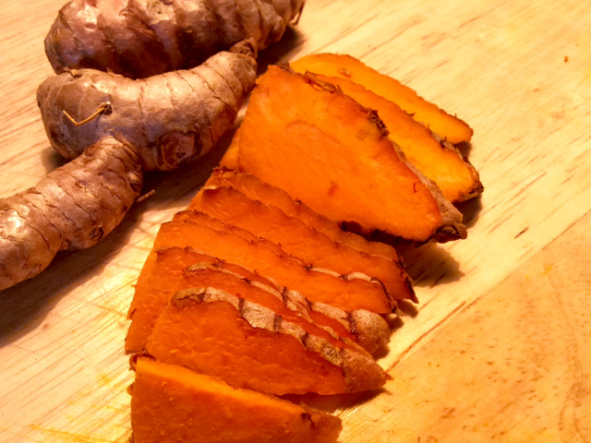
“After women give birth,” my Vietnamese mother-in-law explained, “they get coldness. Turmeric heats the body and protects against colds or flu. Also,” she said, “turmeric makes the skin soft and beautiful again. Any woman who just had a baby should apply a turmeric mask and eat meat or fish kho nghệ (stewed in fish sauce with turmeric), or chicken simmered with turmeric.”
Over the years, various pregnant friends and relatives in Huế have told me they worried about how their skin would look afterwards. Almost all of them used a postpartum mask of fresh turmeric, usually prepared and applied by their mothers-in-law, to heat the body, soften the skin and clear away acne and even melasma, the blotchy brown facial discoloration sometimes called the mask of pregnancy.

A member of the ginger family, turmeric has antioxidant and anti-inflammatory properties. Several varieties grow in Việt Nam. Perhaps the most common are those referred to as yellow turmeric (the one most familiar in the West), red turmeric (with its deeper orange flesh verging on red, and a darker peel), and black turmeric (for medicinal uses only, with a very dark skin and purplish flesh). Both the fresh rhizomes and dried, powdered turmeric are used for cooking and curative purposes. My family mainly uses the yellow variety, Curcuma longa. These roots were for sale at Huế’s Đông Ba Market.

A few days after Trinh, wife of my youngest brother-in-law, had her first baby, Mother grated several chunks of turmeric and soaked the shreds in water. She worked them and squeezed them, discarded the fibres and combined the water with yoghurt to make a thick paste, which she applied to Trinh’s face. When it was dry, Mother rinsed it off and warned Trinh to stay out of the sun, “because you’re more likely to get sunburn or sunstroke.”
“Did your skin turn yellow?” I asked Trinh.
“No, it became paler. The yoghurt stops your skin from turning yellow.”
My husband’s other sister-in-law, Oanh, told me she couldn’t use a turmeric mask. “I tried, but my system is too hot. It gave me acne.”
In Việt Nam, turmeric has a long history as a healing agent, used both internally and on the skin. Andrea Nguyen, in her first cookbook, Into the Vietnamese Kitchen, mentions that fresh turmeric “was traditionally rubbed on cuts or bruises to promote healing.” Today, turmeric skin creams are sold for treatment of mosquito bites and heat rash, prevention of scars, and more. Some friends in Huế use masks made with fresh or powdered turmeric to cure acne, although as Oanh discovered, it can also cause acne in people with a sensitivity.
Việt Nam has recently become one of a handful of countries using nanotechnology to produce a turmeric-based drug called Nano-Curcumin, used to treat cancer. Curcumin, the anti-oxidant, anti-inflammatory chemical in the plant, can suppress growth of cancerous cells, but it isn’t easily dissolved in water and therefore not easily absorbed in the body. Combined with nanoparticles, the curcumin becomes more bioavailable.
The vibrant colour and earthy flavour of turmeric feature in various Vietnamese dishes, from stews and curries to the southern bánh xeò (sizzling pancake—a crispy yellow pancake stuffed with fresh herbs, pork and shrimp) and its smaller, denser Huế cousin, bánh khoái (happy pancake). To make the batter for bánh xèo, I combine dried turmeric with rice flour and coconut milk.
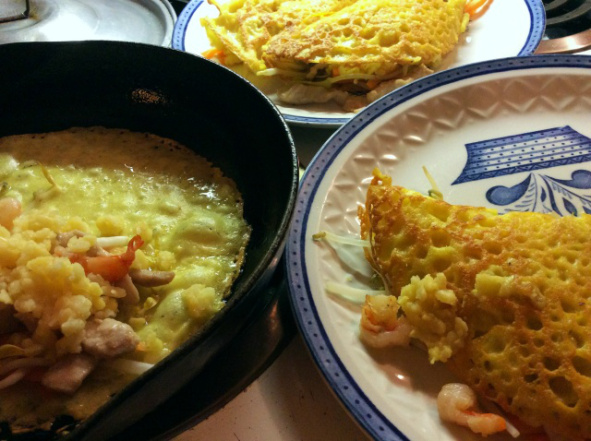
I made these bánh xeò—as I always do—based on Nicole Routhier’s recipe in The Foods of Vietnam. I also love her recipe for bánh tôm chiên, crisp nests of sweet potato and shrimp with a whisper of turmeric. Here’s a shot of some bánh khoái I enjoyed at one of my fave places for this dish in Huế (Bánh Khoái Hạnh, 11 Phó Đức Chính).

From the north comes chả cá (turmeric fish with fresh herbs), and from the eponymous Hà Nội restaurant, the famous Chả Cá Lã Vọng, so delectably described by Kim Fay in Communion: A Culinary Journey Through Vietnam. Andrea Nguyen offers a delightful and easy version of chả cá in Into the Vietnamese Kitchen that features notes of turmeric, galangal and dill.
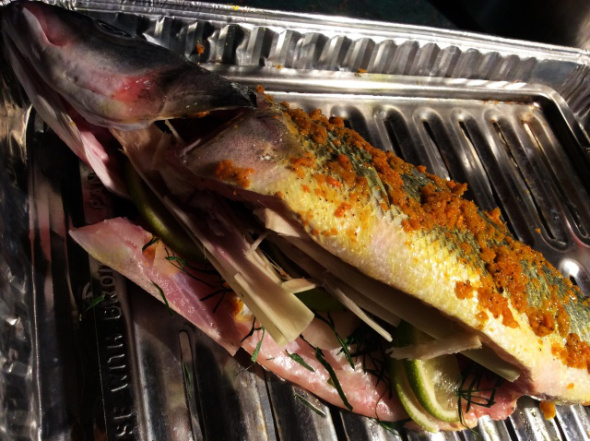
Fresh turmeric is wonderful in a marinade and flavour paste for grilled or stewed fish. I was delighted to find a recipe very similar to one I’d learned from a chef in Huế on Leela Punyaratabandhu’s Thai cooking blog, She Simmers. Leela’s Turmeric-Roasted Fish (ปลาอบขมิ้น) includes one ingredient—coriander root—that I’ve yet to see in Viet cuisine (though I’m sure recipes exist that use it). Leela serves her fish with nam pla prik on the side, a simple dipping sauce of chilies and fish sauce that is right at home in the Viet kitchen. (Leela’s 2014 cookbook, Simple Thai Food, also has some great recipes featuring turmeric, like hot and sour chicken soup with turmeric, and personal fave, turmeric grilled chicken—a fabulous recipe that, when prepared using chicken wings, closely resembles a dish I couldn’t get enough of at a friend’s drinking party in Châu Đốc!)

My cousin-in-law Thủy makes a wonderful vegetarian curry loaded with potatoes and carrots, while sister-in-law Ta makes lòng xào nghệ (bún noodles with turmeric and offal), a popular Central Vietnamese dish for late-afternoon snacking or for nhậu (drinking beer or other alcohol and snacking).
A language note:Lòng means variably the organs in the abdomen, the intestines, bowels or guts, but it figuratively means the heart or soul. In English, you have a good heart, learn something by heart, or have a broken heart; in Vietnamese, you have a good gut (lòng tốt), learn by gut (học thuộc lòng), or have pain in the gut (đau lòng)—or as my go-to online Viet dictionary puts it, you “have heart-breaking bowels.” Hm, lost a bit in translation there…or maybe gained something.
Whenever anyone mentions bún xào nghệ, I picture Ta grating vibrant orange mountains of turmeric, her hands tinted deep yellow. It’s best to wear gloves when handling turmeric, and use glass or steel implements. It will leave a stubborn residue on these materials, but with hot, soapy water, the orange-yellow film can be removed. It will, however, stain plastic irrevocably. If you stain your hands, rubbing with either sugar, oil or lemon juice is said to clear up the colour, but I’ve had no success with any of these. If, like me, you still can’t get rid of the stains, you could try Caroline Lange’s suggestions on the Food 52 blog.
I asked several friends and relatives for their bún xào nghệ recipes. My friend Hiền sent me a video of herself making the dish, but since I can’t upload videos on this blog (one day I’ll upgrade to the paid version), I took a still (below) of her sautéeing the offal with turmeric.
When I asked my sister-in-law for her recipe, she explained her method and said, “If you like a particular ingredient, put more.” Three relatives offered estimates of the quantities they typically use, from which I’ve compiled a list of ingredients with approximate measures, followed by Ta’s instructions, a note, a link to a cold-busting turmeric tea, and a few words on growing your own.
Bún Xào Nghệ
- 250 grams offal
- a handful of coarse salt for cleaning the offal
- 2 turmeric roots
- 1 large clove garlic
- 1 onion
- 1– 2 TB fish sauce
- Pinch msg (optional—my MIL uses a heaping TB)
- 1 TB hạt nêm (optional—may be replaced by increasing the other flavourings)
- 1– 2 tsp dried chilies
- 2 chopped fresh bird chilies
- bún noodles (if fresh, enough for two servings; if dried, about 100 grams per serving, soaked 5 hours – overnight)
- salt to taste
- 2 handfuls ram răm and a handful of chopped green onions
Method, in my sister-in-law’s words, translated:
Rinse offal with coarse salt. Scrape peel off the turmeric (with a spoon or the blunt edge of a knife), then grate the root. The quantity depends on how much you like turmeric—if you love it, put more. One rice-bowlful (about 3/4 cup) should be just right for two to four servings. You need a lot because the turmeric will shrink when you sauté it. (My mother-in-law, on the other hand, says a bowlful is too much for two servings, and recommends “one lạng” of turmeric. Which presents another problem: depending on whom you ask, a lạng can be 100 grams or about 38 grams, a confusion arising from old and newer measuring systems.) Chop garlic and onion.
Heat oil in frying pan. Sauté garlic and onions until aromatic. Add grated turmeric and keep stirring until the mixture starts to get dry and tends to stick.
Add flavourings: fish sauce, msg, hạt nêm (flavour granules)* ground dried chilies and some chopped fresh chilies, according to taste. It should be a little salty.
Finally, add fresh (or soaked and cooked) bún noodles. Toss to combine well and allow the noodles to absorb the flavours. Taste to see if it needs salt. Add rau răm (persicaria herb, sometimes called Vietnamese coriander, pictured below) and green onions and toss again. All that’s left to do, says Ta, is get it into some bowls!

*My in-laws use this chicken flavour hạt nêm and this mushroom-flavoured one, but several other companies make various versions too. While hạt nêm literally means flavour granules, the product seems to be very similar to, if not the same as, instant broth base in the West. Usually, only a tablespoon or so is added to a dish that will serve a whole family. Most hạt nêm contain plenty of msg and salt, so those on low-sodium diets would probably prefer to omit it.
After going on at length about bún with turmeric and offal, I must admit that as a non-fan of offal, I do not crave this dish. My in-laws sometimes do though, and the colour and texture are so appetizing that I am happy to share the offal in my serving with the others, and gobble down the noodles. My friend Thạch suggests asking for the bún nghệ cháy—literally, burnt turmeric noodles—the layer of noodles from the bottom of the frying pan, almost burnt, crisp and intensely flavoured.
In Việt Nam, fresh turmeric is used to prevent or fight colds and sore throats. Slices may be candied, or boiled and the resulting liquid mixed with sugar for a hot beverage. Robyn Eckhardt wrote about her personal experience with the magic of Vietnamese candied turmeric a few years ago. Her method for making it sounds much like the way it’s done in my family and—bonus—the turmeric cocktail recipe she developed to use up the leftover simple syrup is a winner. Robyn’s husband, photographer David Hagerman, has developed a turmeric-based cold-fighting tea that works. Despite fairly robust ingredients, Dave’s Miracle Tea has a delicate flavour and aroma, and is comforting to sip when a cold threatens to ruin a week of your life. I batched some up last week. Here are the ingredients, a little blurry in the steam rising from the pot.
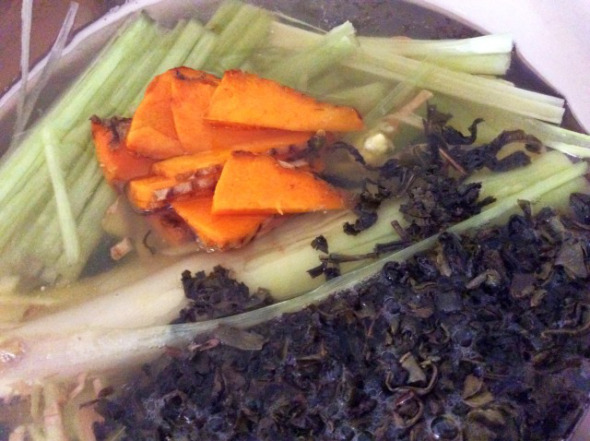
Turmeric is easy to grow from fresh rhizomes bought at a health food store, especially if they already have tiny growing nubs. Give the rhizomes a quick rinse and pot them up. Keep the soil lightly moist, not soaked. It can take a while for the shoots to push through the soil. During this stage, too much water will rot the roots. I plant mine in tubs that I can put outside until the temperature falls to around 10°C in fall. I harvest only pieces the size I need, trying not to disturb the rest. When I bring it in for the winter, sometimes the leaves all dry up and fall, and sometimes a few keep growing, much like the ginger I grow the same way. Both turmeric and ginger roots keep very well in soil—much better than in the fridge or on the counter. Here are some turmeric plants about two months after I planted the rhizomes.

Both turmeric and ginger freeze well, so a good option is to buy them when they look fresh (plump, not wizened and dry-looking), give them a rinse, let them dry and pop them into the freezer, ready for grating or slicing off just the amount you need. For some dishes, though, nothing beats the fresh roots, and in my mother-in-law’s kitchen in Huế, which didn’t even have a fridge until around ten years ago, only fresh turmeric will do.
Advertisements Click to Share:- More





